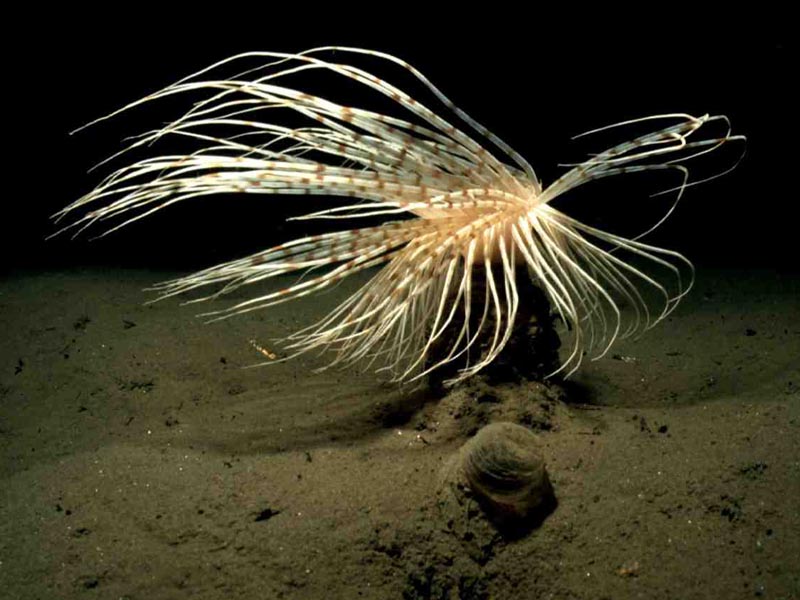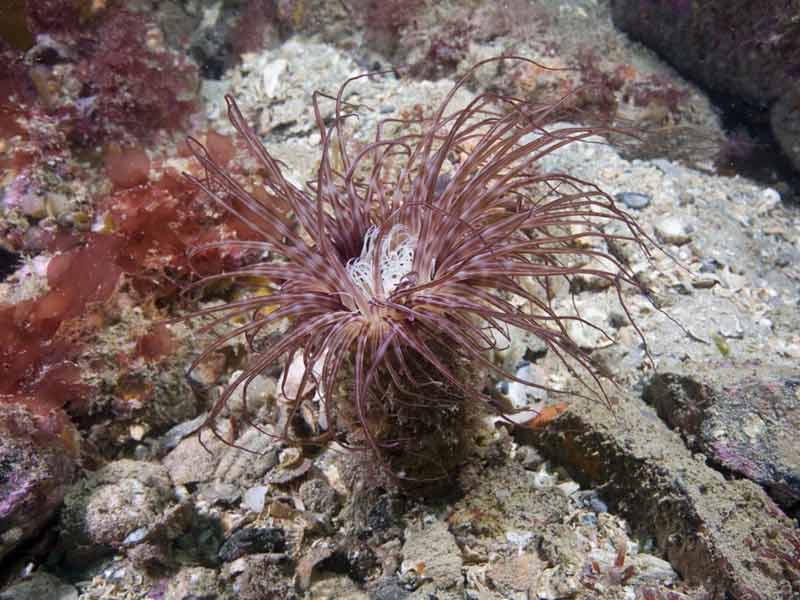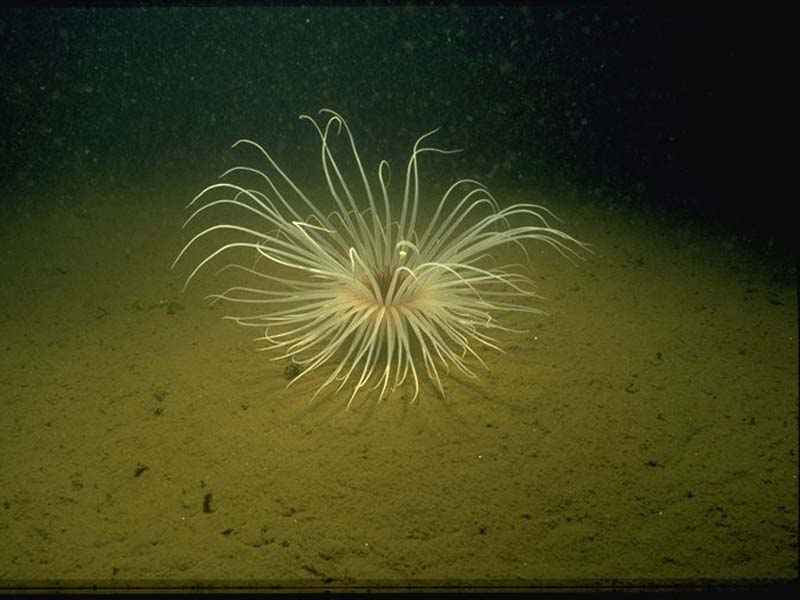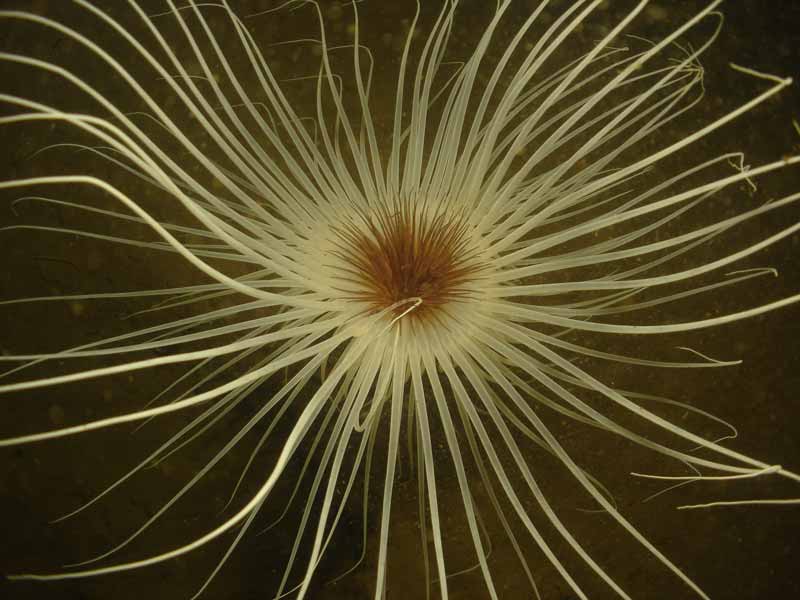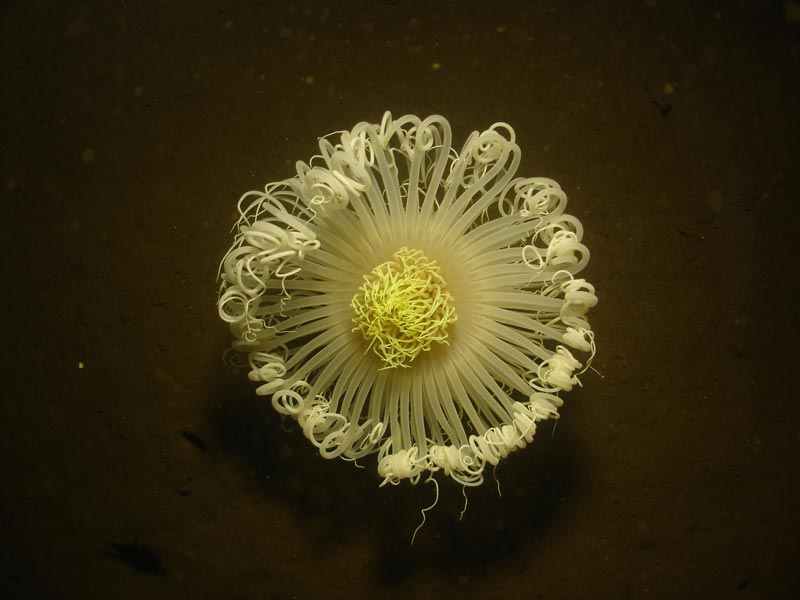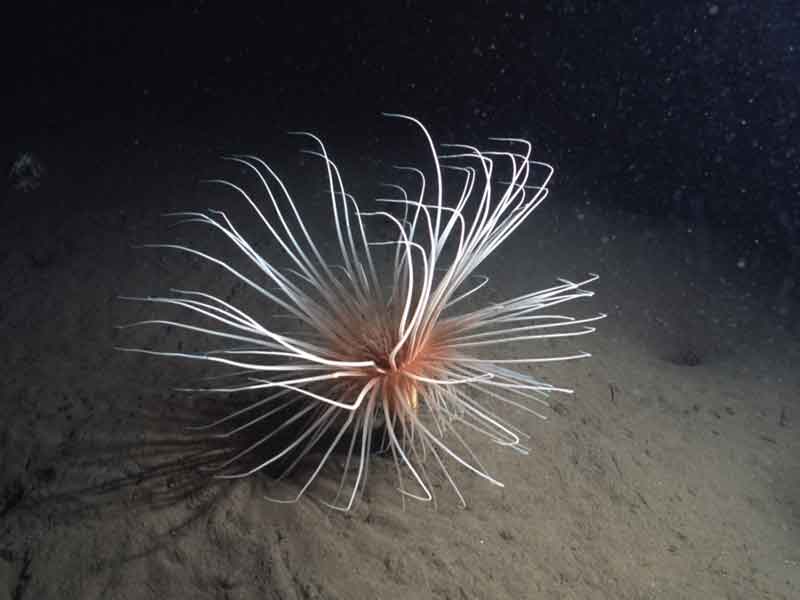Fireworks anemone (Pachycerianthus multiplicatus)
Distribution data supplied by the Ocean Biodiversity Information System (OBIS). To interrogate UK data visit the NBN Atlas.Map Help
| Researched by | Catherine Wilding & Emily Wilson | Refereed by | This information is not refereed |
| Authority | Carlgren, 1912 | ||
| Other common names | - | Synonyms | - |
Summary
Description
Pachycerianthus multiplicatus is a large burrowing anemone, occupying a tube-like burrow that may exceed one metre in length. Both the length of the column and the breadth of the tentacles can reach 30 cm. The tentacles are long and occur in two cycles, with up to 200 tentacles in the marginal cycle. The tentacles are incapable of retraction but may coil spirally on disturbance. The colour of the inner tentacles is pale buff or chestnut and the marginal tentacles are whitish with fine brown bands, or plain white.
Recorded distribution in Britain and Ireland
Recorded from Kenmare River and Kilkieran Bay (western Ireland) and from sea-lochs on the western coast of Scotland, notably Lochs Duich and Fynne.
Global distribution
Outside of the UK, the species has been recorded from the middle of the northern North Sea, due east of Aberdeenshire, and in Scandinavia from Læsø Island in Denmark, Hakefjorden in Sweden and the Trondheim fjord in Norway.
Habitat
Lives in a long thick tube, often over 1 m long, in mud or muddy sand, from about 10-130 m depth. Found only in very sheltered conditions around the head of fijordic sea lochs.
Depth range
10 - 130 mIdentifying features
- Column relatively stout, usually broadest distally, provided with an aboral pore.
- Marginal tentacles arranged in four pseudocycles, up to about 180, very long, even in contraction much longer than disc diameter.
- Attains a very large size.
Additional information
Pachycerianthus multiplicatus is similar to Cerianthus lloydii, but is much longer and has a broader column.
Listed by
Biology review
Taxonomy
| Level | Scientific name | Common name |
|---|---|---|
| Phylum | Cnidaria | Sea anemones, corals, sea firs & jellyfish |
| Class | Anthozoa | Sea anemones, soft & cup corals, sea pens & sea pansies |
| Order | Spirularia | |
| Family | Cerianthidae | |
| Genus | Pachycerianthus | |
| Authority | Carlgren, 1912 | |
| Recent Synonyms | ||
Biology
| Parameter | Data | ||
|---|---|---|---|
| Typical abundance | Moderate density | ||
| Male size range | |||
| Male size at maturity | 30 cm | ||
| Female size range | 30 cm | ||
| Female size at maturity | |||
| Growth form | Radial, Unitary | ||
| Growth rate | See additional information | ||
| Body flexibility | High (greater than 45 degrees) | ||
| Mobility | Burrower | ||
| Characteristic feeding method | Passive suspension feeder | ||
| Diet/food source | Carnivore | ||
| Typically feeds on | Plankton i.e. Sagitta spp. | ||
| Sociability | Solitary | ||
| Environmental position | Infaunal | ||
| Dependency | No information found. | ||
| Supports | No information | ||
| Is the species harmful? | No information | ||
Biology information
Body flexibility. Tentacles are highly flexible and are usually held upright at the base and allowed to flow with the current at the tips. Although they are not retractile, the tentacles may be curled up against the disc if disturbed. The column is comparatively inflexible, although may still lean slightly with the direction of water movement. The tube, into which the whole animal can withdraw, is composed of discharged nematocysts, mucus, and foreign particles, and is soft with a slippery lining.
Growth rate. The growth rate of the species is unknown, but it is thought to be slow, taking several years to reach its full size (Hughes, 1998a).
Larva. Larvae have not yet been identified but are thought to be demersal and short-lived (Molodtsova, 2004), thus larval distribution is likely to be limited. Hughes (1998a) hypothesised that populations were self seeding.
Feeding. The anemone is thought to feed on plankton such as Sagitta spp., and may have weak nematocysts which exclude it from catching larger prey (Jonsson et al., 2001).
Habitat preferences
| Parameter | Data |
|---|---|
| Physiographic preferences | |
| Biological zone preferences | Circalittoral |
| Substratum / habitat preferences | Mud, Mud and sandy mud, Muddy sand |
| Tidal strength preferences | Weak < 1 knot (<0.5 m/sec.) |
| Wave exposure preferences | Extremely sheltered, Ultra sheltered, Very sheltered |
| Salinity preferences | Full (30-40 psu) |
| Depth range | 10 - 130 m |
| Other preferences | No text entered |
| Migration Pattern |
Habitat Information
Lives in a long thick tube, often over 1 m long, in mud or muddy sand, from about 10-130 m depth. Found only in very sheltered conditions around the head of fjordic sea lochs.
Life history
Adult characteristics
| Parameter | Data |
|---|---|
| Reproductive type | Gonochoristic (dioecious) |
| Reproductive frequency | No information |
| Fecundity (number of eggs) | No information |
| Generation time | Insufficient information |
| Age at maturity | Unknown |
| Season | No information found |
| Life span | See additional information |
Larval characteristics
| Parameter | Data |
|---|---|
| Larval/propagule type | - |
| Larval/juvenile development | Lecithotrophic |
| Duration of larval stage | No information |
| Larval dispersal potential | See additional information |
| Larval settlement period | No information |
Life history information
Longevity. Longevity of this species is unknown, but it is thought to be several years (Hughes, 1998a).
Reproduction. The larvae of Pachycerianthus multiplicatus have not yet been identified but are thought to be demersal and short-lived (Molodtsova, 2004) with limited dispersal potential, while most other Ceriantharia larvae are free swimming planktonic carnivores (Manuel, 1988). Unlike most other Anthozoa, Pachycerianthus multiplicatus does not reproduce asexually. When spawning, the male gametes are released first, which stimulates the release of eggs in females (Thorson, 1950).
Sensitivity review
The MarLIN sensitivity assessment approach used below has been superseded by the MarESA (Marine Evidence-based Sensitivity Assessment) approach (see menu). The MarLIN approach was used for assessments from 1999-2010. The MarESA approach reflects the recent conservation imperatives and terminology and is used for sensitivity assessments from 2014 onwards.
Physical pressures
Use / to open/close text displayed
| Intolerance | Recoverability | Sensitivity | Evidence / Confidence | |
Substratum loss [Show more]Substratum lossBenchmark. All of the substratum occupied by the species or biotope under consideration is removed. A single event is assumed for sensitivity assessment. Once the activity or event has stopped (or between regular events) suitable substratum remains or is deposited. Species or community recovery assumes that the substratum within the habitat preferences of the original species or community is present. Further details EvidencePachycerianthus multiplicatus will be removed by removal of the substrata, so intolerance is assessed as high. Due to the fragmented nature of populations, and the assumed limited potential for larval dispersal, recovery is unlikely if the entire population is removed. If mature viable individuals remain in nearby areas to provide larval supply, recovery may be possible, but is likely to take several years. No information was found on larval dispersal or recruitment, and longevity of the species is unknown. As such recoverability is recorded as very low, resulting in a sensitivity assessment of very high. | High | Very low / none | Very High | Very low |
Smothering [Show more]SmotheringBenchmark. All of the population of a species or an area of a biotope is smothered by sediment to a depth of 5 cm above the substratum for one month. Impermeable materials, such as concrete, oil, or tar, are likely to have a greater effect. Further details. EvidencePachycerianthus multiplicatus occurs in muddy sediments, so is likely to be tolerant of some smothering by suspended sediment. Further, the anemone extends up to 30 cm above the surface of the sediment, so a change at the level of the benchmark is unlikely to cause mortality. Additionally, it is plausible that the anemone may be able to extend its tube upwards to adjust to a higher surface level of sediment, although this would incur an energetic cost. Therefore, intolerance is recorded as low. Recoverability is recorded as immediate, resulting in a sensitivity assessment not sensitive. | Low | Immediate | Not sensitive | Very low |
Increase in suspended sediment [Show more]Increase in suspended sedimentBenchmark. An arbitrary short-term, acute change in background suspended sediment concentration e.g., a change of 100 mg/l for one month. The resultant light attenuation effects are addressed under turbidity, and the effects of rapid settling out of suspended sediment are addressed under smothering. Further details EvidencePachycerianthus multiplicatus occurs in muddy sediments, so is likely to be tolerant of some level of suspended sediment. However, there may be an energetic cost of removing mud particles. Therefore, intolerance is recorded as low. Recoverability is recorded as immediate, resulting in a sensitivity assessment not sensitive. | Low | Immediate | Not sensitive | Very low |
Decrease in suspended sediment [Show more]Decrease in suspended sedimentBenchmark. An arbitrary short-term, acute change in background suspended sediment concentration e.g., a change of 100 mg/l for one month. The resultant light attenuation effects are addressed under turbidity, and the effects of rapid settling out of suspended sediment are addressed under smothering. Further details EvidencePachycerianthus multiplicatus occurs in muddy sediments, so is likely to be tolerant of some level of suspended sediment. However, there may be an energetic cost of removing mud particles. A supply of suspended sediment for feeding is probably important to Pachycerianthus multiplicatus, however at the benchmark level of a one month long change, this is thought unlikely to affect the population. Therefore, intolerance is recorded as low. Recoverability is recorded as immediate on return to normal conditions, resulting in a sensitivity assessment not sensitive. | Low | Immediate | Not sensitive | Very low |
Desiccation [Show more]Desiccation
EvidencePachycerianthus multiplicatus is found in the circalittoral, from 10 m and below, so is not likely to experience desiccation. Therefore, this factor is not relevant. Because it is not adapted to cope with desiccation, it is likely to be highly sensitive to this factor, and mortality would be expected. | Not relevant | Not relevant | Not relevant | Not relevant |
Increase in emergence regime [Show more]Increase in emergence regimeBenchmark. A one hour change in the time covered or not covered by the sea for a period of one year. Further details EvidenceBecause the species is circalittoral, changes in emergence routine are not relevant. | Not relevant | Not relevant | Not relevant | Not relevant |
Decrease in emergence regime [Show more]Decrease in emergence regimeBenchmark. A one hour change in the time covered or not covered by the sea for a period of one year. Further details EvidenceSee above. | Not relevant | Not relevant | Not relevant | Not relevant |
Increase in water flow rate [Show more]Increase in water flow rateA change of two categories in water flow rate (view glossary) for 1 year, for example, from moderately strong (1-3 knots) to very weak (negligible). Further details EvidenceNo information was found about effects of increased water flow rate on Pachycerianthus multiplicatus. Another burrowing anemone, Cerianthus lloydii, has been observed to progressively withdraw its tentacles with increasing flow velocity, up to a threshold level of 2-3 knots, after which the anemone completely withdraws into the sediment (Eleftheriou & Basford, 1983). Pachycerianthus multiplicatus is found in sheltered sea lochs with a shallow water sill at the loch entrance, very low water flow rates and minimal flushing. Therefore, an increase in water flow is likely to disturb or remove the muddy substrata in which the species lives. For this reason, intolerance is recorded as high. Recovery is dependent on larval supply, which is thought to be restricted in this species, so is assessed as very low. A resulting sensitivity of very high has been recorded. | High | Very low / none | Very High | Very low |
Decrease in water flow rate [Show more]Decrease in water flow rateA change of two categories in water flow rate (view glossary) for 1 year, for example, from moderately strong (1-3 knots) to very weak (negligible). Further details EvidencePachycerianthus multiplicatus is found in sheltered sea lochs with a shallow water sill at the loch entrance, very low water flow rates and minimal flushing. Therefore, a decrease in water flow is unlikely. It may be possible that a reduction in water flow would reduce food availability to Pachycerianthus multiplicatus, however due to the recorded locations of the species a reduction in water flow at the benchmark level is not deemed relevant. | Not relevant | Not relevant | Not relevant | Not relevant |
Increase in temperature [Show more]Increase in temperature
For intertidal species or communities, the range of temperatures includes the air temperature regime for that species or community. Further details EvidenceNo information was found of the upper or lower thermal tolerance limits of Pachycerianthus multiplicatus. Pachycerianthus multiplicatus occurs in thermally stable conditions. This species is subtidal where wide variations in temperature are not common, so may be intolerant of short term changes in temperature. Therefore, intolerance has been recorded as intermediate. A recoverability of moderate has been recorded, resulting in a sensitivity value of moderate (see additional information below). | Intermediate | Moderate | Moderate | Very low |
Decrease in temperature [Show more]Decrease in temperature
For intertidal species or communities, the range of temperatures includes the air temperature regime for that species or community. Further details EvidenceNo information was found of the upper or lower thermal tolerance limits of Pachycerianthus multiplicatus. Pachycerianthus multiplicatus occurs in thermally stable conditions. This species is subtidal where wide variations in temperature are not common, so may be intolerant of short term changes in temperature. Therefore, intolerance has been recorded as intermediate. A recoverability of moderate has been recorded, resulting in a sensitivity value of moderate (see additional information below). | Intermediate | Moderate | Moderate | Very low |
Increase in turbidity [Show more]Increase in turbidity
EvidenceNo information was found in the literature on the turbidity tolerance of this species. An increase in phytoplankton abundance may be beneficial to the species as it is thought to feed on phytoplankton. As the anemone is not dependent on light, a reduction in light penetration is unlikely to have any effect. Therefore, the species is assessed as tolerant, and not sensitive to this factor. | Tolerant | Not relevant | Not sensitive | Very low |
Decrease in turbidity [Show more]Decrease in turbidity
EvidenceNo information was found in the literature on the turbidity tolerance of this species. At the upper depth limit of Pachycerianthus multiplicatus, a decrease in turbidity may possibly facillitate the growth of algae, due to increased light penetration. However this is unlikely to have an effect on muddy substrata, which lacks suitable attachement sites for algal holdfasts. Also, deeper populations are likely to remain unaffected by changes in turbitity. As the species is highly sensitive to the light from photographic strobes, it may possibly be sensitive to increased light penetration, but this is not likely to have a lethal effect. Therefore intollerance is assessed as low. Recoverability is likely to by very high, resulting in a sensitivity record of very low. | Low | Very high | Very Low | Very low |
Increase in wave exposure [Show more]Increase in wave exposureA change of two ranks on the wave exposure scale (view glossary) e.g., from Exposed to Extremely exposed for a period of one year. Further details EvidenceChanges in wave exposure are unlikely to affect sea lochs, which are areas with little or no wave exposure. A change in wave exposure is highly unlikely, except over geological time-scales, therefore, the sensitivity is not relevant. | Not relevant | Not relevant | Not relevant | Not relevant |
Decrease in wave exposure [Show more]Decrease in wave exposureA change of two ranks on the wave exposure scale (view glossary) e.g., from Exposed to Extremely exposed for a period of one year. Further details EvidenceSee above. | Not relevant | Not relevant | Not relevant | Not relevant |
Noise [Show more]Noise
EvidencePachycerianthus multiplicatus has no known facility for detection of noise vibrations, therefore, is recorded as tolerant. | Tolerant | Not relevant | Not sensitive | Very low |
Visual presence [Show more]Visual presenceBenchmark. The continuous presence for one month of moving objects not naturally found in the marine environment (e.g., boats, machinery, and humans) within the visual envelope of the species or community under consideration. Further details EvidencePachycerianthus multiplicatus probably has a very limited if any ability for visual perception. It is unlikely the anemone will be sensitive to visual presence, however it is thought to be photosensitive as torch light from SCUBA divers causes it to coil its tentacles. This may result in a slight reduction in viability, but is not likely to be significant at the level of the benchmark. Therefore tolerant has been recorded. Recovery may involve small energy losses in extending tentacles, so is assessed to be very high, therefore the species is not sensitive to this factor. | Tolerant | Not relevant | Not sensitive | Very low |
Abrasion & physical disturbance [Show more]Abrasion & physical disturbanceBenchmark. Force equivalent to a standard scallop dredge landing on or being dragged across the organism. A single event is assumed for assessment. This factor includes mechanical interference, crushing, physical blows against, or rubbing and erosion of the organism or habitat of interest. Where trampling is relevant, the evidence and trampling intensity will be reported in the rationale. Further details. EvidenceThe species can coil its tentacles and withdraw into its tube to avoid physical disturbance. It is unclear whether Pachycerianthus multiplicatus would be removed or severely damaged by Nephrops trawling. The anemone does burrow deeply into the mud, however on muddy substrata trawls will dig to a lower depth. So it is likely that at least the upper part of the anemone will come into contact with approaching trawls. Therefore, intolerance is assessed as high. If the anemone was removed or killed, recovery would be very low, resulting in a very high sensitivity assessment. | High | Very low / none | Very High | Very low |
Displacement [Show more]DisplacementBenchmark. Removal of the organism from the substratum and displacement from its original position onto a suitable substratum. A single event is assumed for assessment. Further details EvidenceIt is unknown whether Pachycerianthus multiplicatus can re-bury itself if displaced, although if it can, energy will be expended in forming a new tube, and the anemone may be vulnerable to predation when exposed. | No information | No information | No information | No information |
Chemical pressures
Use [show more] / [show less] to open/close text displayed
| Intolerance | Recoverability | Sensitivity | Evidence / Confidence | |
Synthetic compound contamination [Show more]Synthetic compound contaminationSensitivity is assessed against the available evidence for the effects of contaminants on the species (or closely related species at low confidence) or community of interest. For example:
The evidence used is stated in the rationale. Where the assessment can be based on a known activity then this is stated. The tolerance to contaminants of species of interest will be included in the rationale when available; together with relevant supporting material. Further details. EvidenceInsufficient | No information | No information | No information | No information |
Heavy metal contamination [Show more]Heavy metal contaminationEvidenceInsufficient | No information | No information | No information | No information |
Hydrocarbon contamination [Show more]Hydrocarbon contaminationEvidenceInsufficient | No information | No information | No information | No information |
Radionuclide contamination [Show more]Radionuclide contaminationEvidenceInsufficient | No information | No information | No information | No information |
Changes in nutrient levels [Show more]Changes in nutrient levelsEvidenceNo information could be found on the effects of nutrient enrichment on Pachycerianthus multiplicatus. It is possible that an increase in nutrients will result in greater food availability as the anemone feeds on plankton. However, any deoxygenation associated with the decomposition of organic material is likely to kill Pachycerianthus multiplicatus (Hughes 1998a) (see 'Changes in oxygenation', below). | No information | No information | No information | No information |
Increase in salinity [Show more]Increase in salinity
EvidencePachycerianthus multiplicatus is found in fully saline conditions and it is unlikely that it would be exposed to hypersaline conditions, therefore, not relevant has been recorded. | Not relevant | Not relevant | Not relevant | Not relevant |
Decrease in salinity [Show more]Decrease in salinity
EvidencePachycerianthus multiplicatus is found only in fully saline conditions so it is likely that the sea pen would be intolerant of a decrease in salinity. Therefore, an intolerance of high has been recorded. A recoverability of low has been recorded, resulting in a high sensitivity value. | High | Low | High | Very low |
Changes in oxygenation [Show more]Changes in oxygenationBenchmark. Exposure to a dissolved oxygen concentration of 2 mg/l for one week. Further details. EvidenceThere is no evidence was found on the tolerance of Pachycerianthus multiplicatus to deoxygenation. Jones et al., (2000) found that burrowing infaunal species generally require well oxygenated conditions. Burrowing megafauna were absent from de-oxygenated areas which are characterised by nutrient enrichment resulting in a hypoxia bacterial community, so aquaculture wastes are likely to affect burrowing megafauna. Additionally, the removal of oxygenating bioturbators by trawling may result in eutrophication and deoxygenation (Ball et al., 2000). Therefore, intolerance has been recorded as high. A recoverability of moderate has been recorded, resulting in a moderate sensitivity assessment. | High | Moderate | Moderate | Very low |
Biological pressures
Use [show more] / [show less] to open/close text displayed
| Intolerance | Recoverability | Sensitivity | Evidence / Confidence | |
Introduction of microbial pathogens/parasites [Show more]Introduction of microbial pathogens/parasitesBenchmark. Sensitivity can only be assessed relative to a known, named disease, likely to cause partial loss of a species population or community. Further details. EvidenceInsufficient | No information | No information | No information | No information |
Introduction of non-native species [Show more]Introduction of non-native speciesSensitivity assessed against the likely effect of the introduction of alien or non-native species in Britain or Ireland. Further details. EvidenceInsufficient | No information | No information | No information | No information |
Extraction of this species [Show more]Extraction of this speciesBenchmark. Extraction removes 50% of the species or community from the area under consideration. Sensitivity will be assessed as 'intermediate'. The habitat remains intact or recovers rapidly. Any effects of the extraction process on the habitat itself are addressed under other factors, e.g. displacement, abrasion and physical disturbance, and substratum loss. Further details. EvidencePachycerianthus multiplicatus is not known to be harvested, although due to the fragmented and localized distribution of populations, the species is likely to be highly sensitive to this factor. | Not relevant | Not relevant | Not relevant | Not relevant |
Extraction of other species [Show more]Extraction of other speciesBenchmark. A species that is a required host or prey for the species under consideration (and assuming that no alternative host exists) or a keystone species in a biotope is removed. Any effects of the extraction process on the habitat itself are addressed under other factors, e.g. displacement, abrasion and physical disturbance, and substratum loss. Further details. EvidenceIn Loch nam Madadh Pachycerianthus multiplicatus has been recorded from the same biotope as Nephrops norvegicus, (Entec 1996; Howson & Davies, 1991). It is unclear whether Pachycerianthus multiplicatus would be removed or severely damaged by Nephrops trawling. The anemone does burrow deeply into the mud, however on muddy substrata trawls will dig down to a lower depth. So it is likely that at least the upper part of the anemone will come into contact with approaching trawls. Additionally, the removal of oxygenating bioturbators by trawling may result in eutrophication and deoxygenation (Ball et al., 2000a). Therefore, intolerance is assessed as high. If the anemone was removed or killed, recovery would be very low, resulting in a very high sensitivity assessment. | High | Very low / none | Very High | Very low |
Additional information
Due to a deficit of available information, this sensitivity assessment has been made based on available life history information.
Recoverability
Although no conclusive literature was found, it is thought that the species has a very limited capacity for larval dispersal and recolonization, and populations are likely to be self-seeding (Hughes, 1998a). Hughes (1998a) suggested slow growth and a long life span. Due to the fragmented nature of populations, the species is likely to be highly vulnerable to localised extinction. Recoverability is dependent on recolonization from other populations, therefore if the entire population is destroyed, it is unlikely to ever recover.
Importance review
Policy/legislation
| Designation | Support |
|---|---|
| UK Biodiversity Action Plan Priority | Yes |
| Scottish Biodiversity List | Yes |
Status
| National (GB) importance | Not rare or scarce | Global red list (IUCN) category | - |
Non-native
| Parameter | Data |
|---|---|
| Native | - |
| Origin | - |
| Date Arrived | - |
Importance information
Pachycerianthus multiplicatus was listed in the UK Biodiversity Action Plan as a species of conservation concern (Biodiversity Steering Group, 1995). The species is also nationally rare, and due to its limited, fragmented distribution, British populations are also likely to be of global importance.
Bibliography
Ball, B.J., Fox, G. & Munday, B.W., 2000. Long- and short-term consequences of a Nephrops trawl fishery on the benthos and environment of the Irish Sea. ICES Journal of Marine Science, 57, 1315-1320.
Eleftheriou, A. & Basford, D.J., 1983. The general behaviour and feeding of Cerianthus lloydii Gosse (Anthozoa, Coelenterata). Cahiers de Biologie Marine, 24, 147-158.
Entec, A. 1996. Broad scale habitat mapping of intertidal and subtidal coastal areas: Loch Maddy, North Uist In Scottish Natural Heritage Research, Survey and monitoring Report No. 76
Hayward, P.J. & Ryland, J.S. (ed.) 1995b. Handbook of the marine fauna of North-West Europe. Oxford: Oxford University Press.
Howson, C.M. & Davies, L.M., 1991. Marine Nature Conservation Review, Surveys of Scottish Sea Lochs. A towed video survey of Loch Fyne. Vol. 1 - Report. Report to the Nature Conservancy Council from the University Marine Biological Station, Millport.
Howson, C.M. & Picton, B.E., 1997. The species directory of the marine fauna and flora of the British Isles and surrounding seas. Belfast: Ulster Museum. [Ulster Museum publication, no. 276.]
Hughes, D.J., 1998a. Sea pens & burrowing megafauna (volume III). An overview of dynamics and sensitivity characteristics for conservation management of marine SACs. Natura 2000 report prepared for Scottish Association of Marine Science (SAMS) for the UK Marine SACs Project., Scottish Association for Marine Science. (UK Marine SACs Project). Available from: http://ukmpa.marinebiodiversity.org/uk_sacs/pdfs/seapens.pdf
Hughes, D.J., 1998b. Subtidal brittlestar beds. An overview of dynamics and sensitivity characteristics for conservation management of marine SACs. Natura 2000 report prepared for Scottish Association of Marine Science (SAMS) for the UK Marine SACs Project., Scottish Association for Marine Science. (UK Marine SACs Project, Vol. 3). Available from: http://ukmpa.marinebiodiversity.org/uk_sacs/pdfs/britstar.pdf
Jones, L.A., Hiscock, K. & Connor, D.W., 2000. Marine habitat reviews. A summary of ecological requirements and sensitivity characteristics for the conservation and management of marine SACs. Joint Nature Conservation Committee, Peterborough. (UK Marine SACs Project report.). Available from: http://ukmpa.marinebiodiversity.org/uk_sacs/pdfs/marine-habitats-review.pdf
Jonsson, L.G., Lundälv, T. & Johannesson, K., 2001. Symbiotic associations between anthozoans and crustaceans in a temperate coastal area Marine Ecology Progress Series, 209, 189-195
Manuel, R.L., 1988. British Anthozoa. Synopses of the British Fauna (New Series) (ed. D.M. Kermack & R.S.K. Barnes). The Linnean Society of London [Synopses of the British Fauna No. 18.]. DOI https://doi.org/10.1002/iroh.19810660505
Molodtsova, T.N., 2004. On the taxonomy and presumable evolutionary pathways of planktonic larvae of Ceriantharia (Anthozoa, Cnidaria). Hydrobiologia, 530/531, 261-266
Naylor. P., 2005. Great British Marine Animals, 2nd Edition. Plymouth. Sound Diving Publications.
Thorson, G., 1950. Reproductive and larval ecology of marine bottom invertebrates. Biological Reviews, 25, 1-45.
Wood. C., 2005. Seasearch guide to sea anemones and corals of Britain and Ireland. Ross-on-Wye: Marine Conservation Society.
Datasets
NBN (National Biodiversity Network) Atlas. Available from: https://www.nbnatlas.org.
OBIS (Ocean Biodiversity Information System), 2025. Global map of species distribution using gridded data. Available from: Ocean Biogeographic Information System. www.iobis.org. Accessed: 2025-08-05
Citation
This review can be cited as:
Last Updated: 24/04/2008

